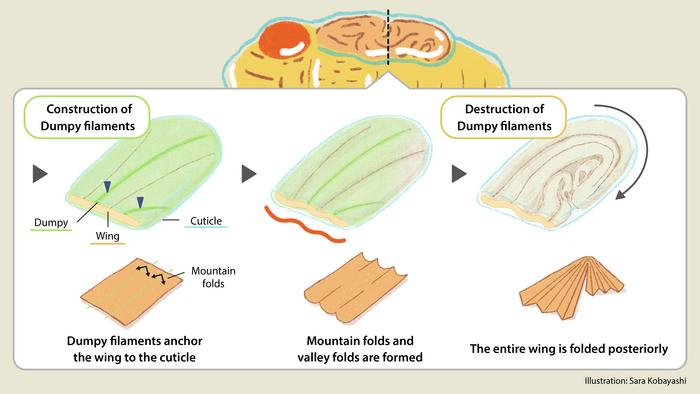In the realm of nature, mesmerizing geometric patterns form. A striking example of this can be witnessed in the wings of Drosophila fruit flies as they emerge from their pupal case, a process known as eclosion.
 Construction and destruction of Dumpy filaments in Drosophila wing. Image Credit: KyotoU/Sara Kobayashi
Construction and destruction of Dumpy filaments in Drosophila wing. Image Credit: KyotoU/Sara Kobayashi
These delicate structures meticulously unfurl into stereotypical forms, reminiscent of the intricate artistry found in the ancient practice of origami.
Remarkably, this transformation unfolds with astonishing precision, guided solely by nature’s intricate design, requiring no human intervention whatsoever.
Recently, Kyoto University researchers have unveiled a pivotal discovery: they have determined that the Dumpy protein, a constituent of extracellular matrices (ECM), plays a central role in governing the precise, origami-like folding of wing-cell sheets.
Our findings are unique because they unveil how external cues can create consistent 3D tissue structures.”
Alice Tsuboi, Study First Author, Graduate School of Biostudies, Kyoto University
In accordance with traditional perspectives on morphogenesis, it has been commonly believed that orchestrated cellular actions, including processes like cell division and alterations in cell shapes, are accountable for sculpting cell sheets and forming folds, such as the intricate mountain-valley patterns. Researchers might naturally infer that wing folding is regulated by these cellular behaviors.
It turns out, however, that wing cells never divide during folding nor do they exhibit spatially distinct behaviors.”
Alice Tsuboi, Study First Author, Graduate School of Biostudies, Kyoto University
These surprising discoveries prompted Tsuboi's research group to explore the possibility of external influences governing the folding pattern. Through the utilization of genetic methods and protein visualization techniques, the team uncovered that a fibrous ECM protein called Dumpy plays a pivotal role in facilitating the adhesion of cell sheets to their environment.
Furthermore, the precise orchestration of Dumpy deposition and degradation, both in terms of location and timing, guarantees the consistent and stereotypical folding of the wing.
“During a casual walk, I stumbled upon the eclosion of a cicada, which triggered my interest in the morphogenic mechanisms involved,” states Tsuboi, who visualizes an opportunity to investigate whether an ECM-based mechanism may be a means to manufacturing diverse and controllable 3D tissue folding with coordinated cell behaviors.
We believe that the next step is in examining how tissues encode positional information in ECM remodeling, which may provide new insight into organ development and regeneration.”
Alice Tsuboi, Study First Author, Graduate School of Biostudies, Kyoto University
Source:
Journal reference:
Tsuboi, A., et al. (2023) Spatiotemporal remodeling of extracellular matrix orients epithelial sheet folding. Science Advances. doi.org/10.1126/sciadv.adh2154.